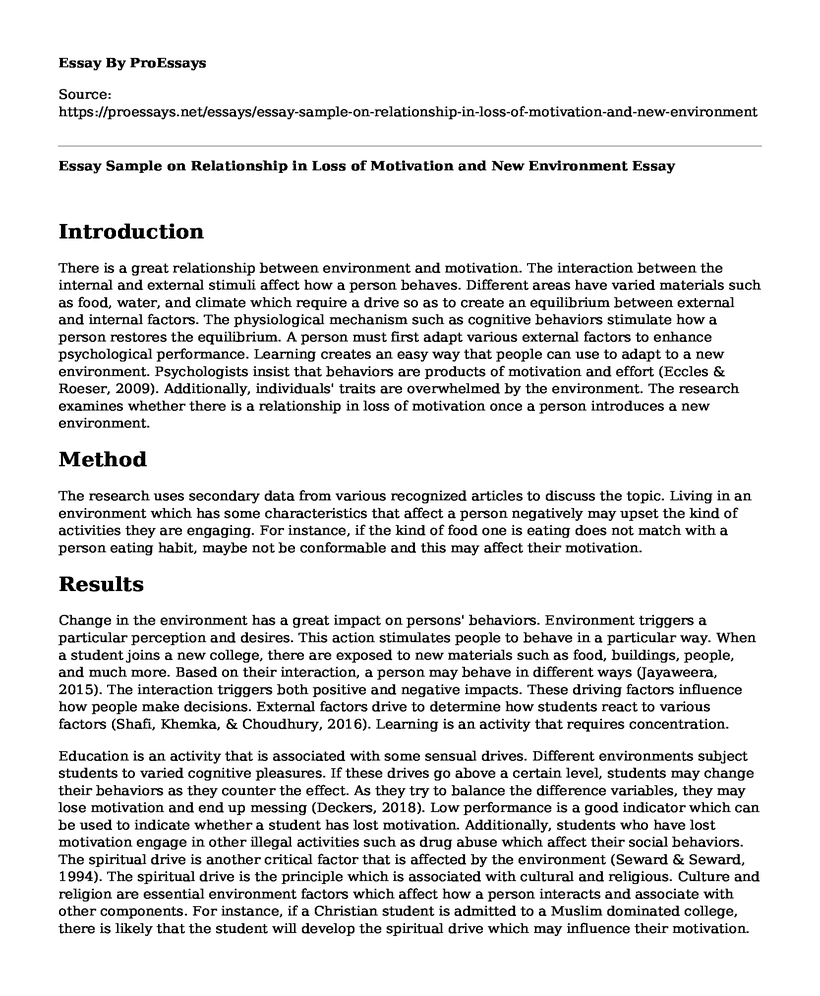Introduction
There is a great relationship between environment and motivation. The interaction between the internal and external stimuli affect how a person behaves. Different areas have varied materials such as food, water, and climate which require a drive so as to create an equilibrium between external and internal factors. The physiological mechanism such as cognitive behaviors stimulate how a person restores the equilibrium. A person must first adapt various external factors to enhance psychological performance. Learning creates an easy way that people can use to adapt to a new environment. Psychologists insist that behaviors are products of motivation and effort (Eccles & Roeser, 2009). Additionally, individuals' traits are overwhelmed by the environment. The research examines whether there is a relationship in loss of motivation once a person introduces a new environment.
Method
The research uses secondary data from various recognized articles to discuss the topic. Living in an environment which has some characteristics that affect a person negatively may upset the kind of activities they are engaging. For instance, if the kind of food one is eating does not match with a person eating habit, maybe not be conformable and this may affect their motivation.
Results
Change in the environment has a great impact on persons' behaviors. Environment triggers a particular perception and desires. This action stimulates people to behave in a particular way. When a student joins a new college, there are exposed to new materials such as food, buildings, people, and much more. Based on their interaction, a person may behave in different ways (Jayaweera, 2015). The interaction triggers both positive and negative impacts. These driving factors influence how people make decisions. External factors drive to determine how students react to various factors (Shafi, Khemka, & Choudhury, 2016). Learning is an activity that requires concentration.
Education is an activity that is associated with some sensual drives. Different environments subject students to varied cognitive pleasures. If these drives go above a certain level, students may change their behaviors as they counter the effect. As they try to balance the difference variables, they may lose motivation and end up messing (Deckers, 2018). Low performance is a good indicator which can be used to indicate whether a student has lost motivation. Additionally, students who have lost motivation engage in other illegal activities such as drug abuse which affect their social behaviors. The spiritual drive is another critical factor that is affected by the environment (Seward & Seward, 1994). The spiritual drive is the principle which is associated with cultural and religious. Culture and religion are essential environment factors which affect how a person interacts and associate with other components. For instance, if a Christian student is admitted to a Muslim dominated college, there is likely that the student will develop the spiritual drive which may influence their motivation.
Conclusion
There is a vital relationship between loss of motivate and a new environment. New environment exposes a student in new external factors which affects the equilibrium between external and internal drives. Adapting a new environment is a critical issue which may trigger stress that affecting the core goals. If a person has no ability to balance external and internal drives, the dominant drive takes over. As a result, students lose their motivation as they try to uplift the affected. Most of them engage in illegal activities as they try to balance the issue.
References
Deckers, L. (2018). Motivation: Biological, psychological, and environmental. Routledge.
Eccles, J. S., & Roeser, R. W. (2009). Schools, academic motivation, and stageenvironment fit. Handbook of adolescent psychology, 1.
Jayaweera, T. (2015). Impact of work environmental factors on job performance, mediating role of work motivation: a study of hotel sector in England. International journal of business and management, 10(3), 271.
Seward, G. H., & Seward, J. P. (1937). Internal and external determinants of drives. Psychological Review, 44(4), 349.
Shafi, A. A., Khemka, M., & Roy Choudhury, S. (2016). A new approach to motivation: Four-drive model. Journal of Human Behavior in the Social Environment, 26(2), 217-226.
Cite this page
Essay Sample on Relationship in Loss of Motivation and New Environment. (2022, Dec 04). Retrieved from https://proessays.net/essays/essay-sample-on-relationship-in-loss-of-motivation-and-new-environment
If you are the original author of this essay and no longer wish to have it published on the ProEssays website, please click below to request its removal:
- Paper Example on Child Development
- Online Learning: Discussion Participation Assessed - Essay Sample
- School Principal: Leader, Link & Policy Enforcer - Essay Sample
- Essay Example on UK School Performance Measurement: Pros & Cons
- Essay Example on Video Gaming: Positive and Negative Effects on Child Development
- Article Analysis Essay on Ethics of Literacy Research in the 21st Century
- Paper Example on Bullying Behavior: A Global Problem Requiring Maximum Focus







